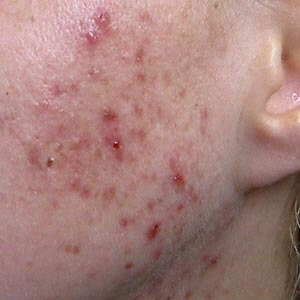Demystifying Acne: Understanding Its Root Causes | |||
 1,370 1,370  0 0  0 0 | |||
The Multifactorial Nature of AcneAcne is not simply a result of one single cause, but rather a complex interplay of several contributing factors. At its core, acne arises from inflammation within the hair follicles (pilosebaceous units), triggered by a combination of events. Understanding these factors is crucial for effective prevention and treatment.
Increased Sebum Production: The Oily FoundationSebaceous glands produce sebum, an oily substance designed to lubricate and protect the skin. However, overproduction of sebum creates a prime environment for acne development. This overproduction is often driven by hormonal fluctuations, particularly an increase in androgens (male hormones) during puberty, menstruation, pregnancy, or even from certain medications.
Clogged Pores: The Beginning of the BlockageExcess sebum, combined with dead skin cells, can clog hair follicles. These clogged pores form comedones, commonly known as blackheads (open comedones) and whiteheads (closed comedones). This blockage traps bacteria and cellular debris, setting the stage for inflammation.
Cutibacterium Acnes: The Bacterial ContributorCutibacterium acnes (formerly Propionibacterium acnes) is a bacterium that naturally resides on the skin. While it's a normal part of the skin's flora, when trapped within clogged pores, it proliferates rapidly. This overgrowth contributes significantly to the inflammatory response, leading to the formation of various types of acne lesions, including papules (pimples), pustules (pus-filled pimples), nodules, and cysts.
Inflammation: The Immune System's ResponseThe body's immune system recognizes the trapped sebum, bacteria, and dead skin cells as foreign invaders. This triggers an inflammatory response, resulting in the redness, swelling, pain, and heat characteristic of acne lesions. The inflammatory process is central to the development and progression of acne.
Genetic Predisposition: Family MattersA family history of acne significantly increases an individual's risk of developing the condition. This suggests a genetic component influencing various aspects related to acne, such as sebum production levels, pore size, susceptibility to inflammation, and the immune system's response to C. acnes.
Hormonal Changes: The Fluctuating FactorHormonal fluctuations play a significant role in acne development, particularly those associated with puberty, menstruation, pregnancy, and the use of certain medications. These hormonal shifts often lead to increased sebum production, making individuals more susceptible to clogged pores and subsequent acne breakouts.
Other Contributing Factors: Diet, Stress, and LifestyleWhile the direct link between diet and acne is still debated, some studies suggest that certain foods, particularly those with a high glycemic index, may exacerbate acne in some individuals. Similarly, stress can trigger hormonal changes that contribute to increased sebum production and inflammation. Certain cosmetics and medications can also clog pores or irritate the skin, worsening acne. Tags: Acne Cutibacterium Acnes Demystifying Acne Dermatology Healthy Skin Hormonal Changes Pimples Propionibacterium Acnes Sebum Production Skin Health | |||
| |||
| | |||
|
 3224
3224 